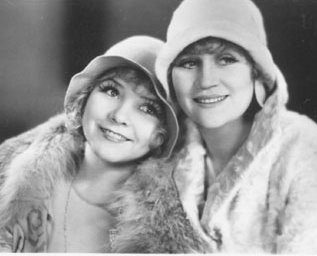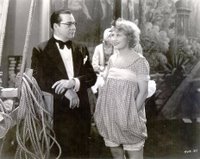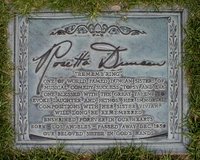###
31 October 2006
A Ghost That Never Walked
###
29 October 2006
"Syncopated Bells are Ringing..."
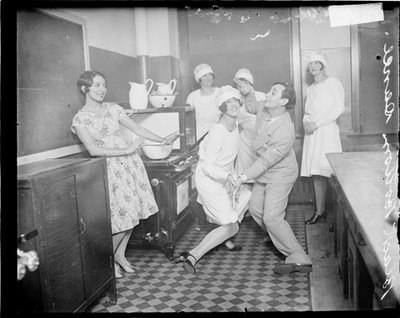
For an American enthusiast and collector of popular music circa 1900-1935 such as myself, a point is invariably reached where you deem you've "heard it all," or at least every new vintage disc or cylinder you encounter seems --- if not an old familiar friend, then at least a vaguely remembered acquaintance.
Providing a much needed diversion then, comes music from a distant shore --- the United Kingdom, to be precise. The melodies may be familiar, but the labels they're recorded on aren't --- and neither are the names of the recording artists. In an odd way, it's not unlike encountering an unknown alternate universe of sorts, with each disc about to be spun containing the prospect of a pleasant surprise.
To be fair, when all is said and done, the pleasant surprises weren't as frequent nor memorable as hoped for, but amidst all the dusty shellac lurk gems. Then too, there's an almost indescribable inherent difference in British jazz from the American counterparts of the period. A combination of difference in recording technique (UK jazz of the period always sounds like it was recorded in an echo heavy cathedral) and, certainly in performance style. No matter how hot and low-down the tune, it seems to have been played by musicians clad in tuxedos with crisp wing-tip collars who never perspire or utter an oath. Of course, I'm sure that such wasn't the case --- now, then or ever --- but there's a peculiar element of dignified reserve involved that I find irresistibly charming, evocative and beautifully effective.
First up, is "Da-Dn-Da" from 1930, recorded by "The Ever Bright Boys" (an alternate name for Percival MacKay's band) on the Piccadilly label. Absolutely joyous nonsense, this --- all about love hungry males (advised to "catch 'em young and treat 'em rough!") and reluctant females, with an incredibly focused and wonderfully lunatic vocal that you won't soon forget!
"Da-Dn Da" (1930)
We next move ahead to 1931 and "The Peanut Vendor," with a then still exotic and slightly risque Cuban rhythm that made it irresistible to listeners and dancers alike. Widely recorded and highlighted in the 1931 Metro film "The Cuban Love Song," it's performed here by the Marius B. Winter band (again on the "Broadcast" label) with verve and caliente enthusiasm aplenty.
"The Peanut Vendor" (1931)
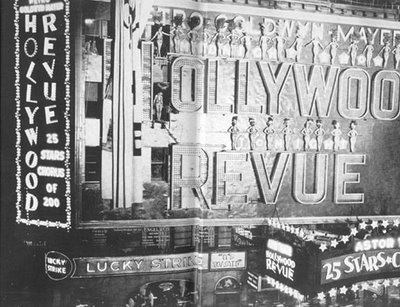
From the first wave of screen musicals that arrived in 1929, comes "Low Down Rhythm" from MGM's mammoth all-star screen vaudeville, "The Hollywood Revue." As presented in the film, the tune served to first conjure up the fondly recalled music of the past and then to present a natural musical progression of sorts to this new rhythm of jazz, indicating it needed to be "taken up to the skies" and introduced to an undoubtedly unimpressed Saint Peter at the heavenly gate. Of all the many, many renditions of the tune recorded in 1929 and 1930 (the tune would even turn up in the 1933 Jean Harlow film "Bombshell",) I like this version the best --- with a violin sweetly swirling all about the tricky syncopated rhythm, and a charming vocalist who sounds as though he'd rather be singing "Annie Laurie." A gem.
"Low Down Rhythm" (1930)
From 1928, a real oddity --- the details of which are unknown to me, except that for some wonderful reason, four noted British jazz bands combined their skill (and musicians) under one roof to record "Bless Her Little Heart," and nearly succeeded in blowing that said roof off! Indeed, the grooves of the record can barely contain the sound! The tune itself isn't exceptional --- but there's an almost overwhelming musical tidal wave on display here that seems as though could have been heard for blocks and blocks away from wherever it was recorded. Imagine having been there. So then, here are the combined bands of Debroy Somers, the Piccadilly Revels, the Kit Kat Band and the London Radio Band with "Bless Her Little Heart," under the direction of one Mr. Al Starita.
"Bless Her Little Heart" (1928)
 The marvelous 1930 Paramount film "Honey" ("A Musical Farce") survives today in a never-never land of limbo, with litigation and ignorance holding it under lock and key --- but when seen it offers an incredible abundance of pleasures, chief among them the performances of Nancy Carroll, Skeets Gallagher, Lillian Roth, ZaSu Pitts and Mitzi Green. And then, among the tuneful moments, there's the hell raising "Sing You Sinners" which comes out of nowhere and raises the film to gleeful levels that can't easily be described. Harry Hudson and his Orchestra, recording here as "The Blue Jays" for the "Radio" 78rpm label, give fair indication of what I mean:
The marvelous 1930 Paramount film "Honey" ("A Musical Farce") survives today in a never-never land of limbo, with litigation and ignorance holding it under lock and key --- but when seen it offers an incredible abundance of pleasures, chief among them the performances of Nancy Carroll, Skeets Gallagher, Lillian Roth, ZaSu Pitts and Mitzi Green. And then, among the tuneful moments, there's the hell raising "Sing You Sinners" which comes out of nowhere and raises the film to gleeful levels that can't easily be described. Harry Hudson and his Orchestra, recording here as "The Blue Jays" for the "Radio" 78rpm label, give fair indication of what I mean:"Sing You Sinners" (1930)
I'll close this installment (of which there will be sequels, I'm sure) with what I consider to be the ultimate British recording of the period. Titled "You Are My Heart's Delight" --- a reworking of the classic Franz Lehar melody --- the tune serves here as a backdrop to introduce The Savoy Hotel Orpheans, an ensemble that personifies elegance on top of more elegance.. Each musician is introduced, along with their instrumental contribution as they join in with the melody, by announcer Norman Long and the effect is so lovely and unusual that it's bound to raise the hairs on the back of the neck of more sensitive (or sentimental) listeners, of which I consider myself unduly both. It was recorded for Columbia UK.
"You Are My Hearts Delight" (1931)
Photographs from the Chicago Daily News Courtesy of the Chicago Historical Society (#DN-0081644 and #DN-0078352)
In the Land of Jazz
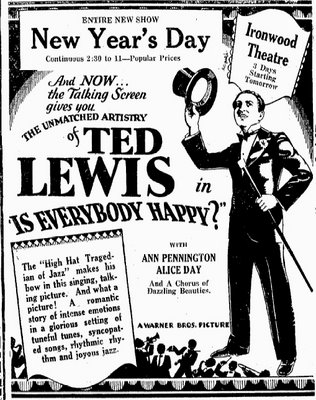
If there's such a thing as a Land of Jazz, then I imagine it's one of the few bright corners in the Land of Lost Films, which is where the motion picture to our right currently resides, holding nightly court with thousands of other movies that meekly claim this unhappy territory as their Country of Residence.
Victims of neglect, fire, mishandling, self-destruction, greed and folly, most lost films leave traces of themselves behind --- clues both plain and cryptic that while seldom leading to their discovery and rescue, at the very least serve to provide some idea of what they were like.
Although reading about a film we can no longer see can often be fascinating, doing so is ultimately frustrating and unsatisfying --- like someone describing a delicious meal in great detail that you could have partaken in had you arrived only a few hours earlier. But, we've no choice except to work with what we have --- and sometimes, we have more than just printed text and visual mediums --- much more, in fact.
In the case of early talking films, the Warner Brothers Vitaphone product in particular, although the picture (film) element may seem to have ceased to exist in either private or public hands, oftentimes what's left behind is the film's soundtrack --- which was recorded on discs that played in synchronization with the film. Such a film was "Is Everybody Happy?" a serio-comic musical released by Warner Brothers to theaters in late October of 1929, with bandleader, musician and recording artist Ted Lewis as it's star, and who's signature phrase prompted the film's title --- which must have looked rather jarring on theater marquees to a public as yet unsure of what to make of the odd circumstances occurring on Wall Street in the last week of that month.
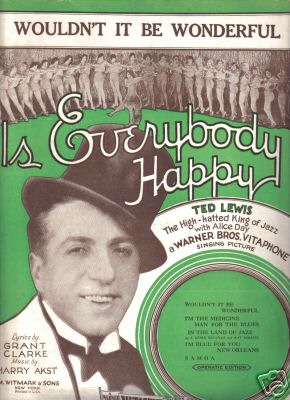 Today, we have so much of the various elements of "Is Everybody Happy?" that at times the missing visual element, the film itself, seems almost besides the point. Almost. We've sheet music, printed contemporary reviews, a complete transcript of the film's dialogue script, 78rpm commercial recordings of tunes from the film, photographic stills, movie posters, countless newspaper ads and printed publicity items including colorful advertising heralds and posters.
Today, we have so much of the various elements of "Is Everybody Happy?" that at times the missing visual element, the film itself, seems almost besides the point. Almost. We've sheet music, printed contemporary reviews, a complete transcript of the film's dialogue script, 78rpm commercial recordings of tunes from the film, photographic stills, movie posters, countless newspaper ads and printed publicity items including colorful advertising heralds and posters.Lastly, but not least, we have not one but two complete soundtracks for the film that were recorded on the aforementioned Vitaphone disc system. One is the soundtrack that would have been heard along with the film in any English speaking territory in the world, and the other was especially recorded for a slightly abbreviated version of the film that was prepared for release in countries where the English language wasn't widely understood or spoken. For this export version, most of the film's dialogue was removed and replaced with explanatory title-cards written in the appropriate foreign language and the resulting product was largely a silent film with a pre-recorded musical and sound effects score. Left intact, however --- and this was the case with virtually all musical films doctored for international export at the time --- was the music and song sequences as originally performed in the film, for these presumably needed no translation, although what the patrons of a Bolivian cinema made of flashy scenes of chorus girls prancing about in New York night clubs is something lost to time and memory.
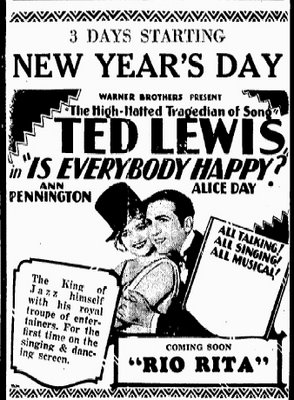
The plot of "Is Everybody Happy?" isn't far removed from that of "The Jazz Singer," in that it's the old, old story of Tradition vs. Modern Society, Age vs. Youth --- and as always, the new wins out over the old. Here, Ted (Lewis) and his family emigrate to New York City from Budapest, where Ted's aged father was a renowned violinist. Ted happens upon his old girlfriend from Budapest, Lena (Ann Pennington) who has successfully shaken off both Europe and her accent as a shimmy dancer in a vaudeville house. Ted is smitten with jazz and displays brilliant talent on a borrowed clarinet, but lacks his own instrument. Without giving much thought to the consequences, Ted sells his father's prized violin (given to him personally by the Emperor Franz Joseph) and before long is a smash success. His father, crushed and heartbroken, leaves his home, wife and son to wander off to points unknown.
As could be expected, Ted's fantastic success (he has his own night club by now) means nothing without his father's love --- and to make matters worse, his own once hot relationship with Lena has now become a noose about his neck, for he has eyes only for a lovely blonde chorine is his new club, Gail (Alice Day.) Just when things look their blackest for Ted, at Christmas of course, Lena cuts Ted loose, his Father arrives on the scene (via the nightclub where he first confides in Lena who urges a reconciliation), and everyone gathers for a bountiful dinner --- Mom, Dad, Ted, Gail and even Lena --- as Ted serenades his extended family with the film's theme song, "Wouldn't It Be Wonderful."
Audio Addendum:
For this entry, I'm offering four representative audio excerpts from both the domestic and international release versions of the surviving Vitaphone disc soundtrack which you can listen to by clicking on the links, although right-clicking and saving will allow for far smoother playback.
1) It's a melancholy Christmas for Ted, but his Mother --- although seemingly abandoned by her husband, is curiously chirpy despite it all. (Ted Lewis, Julia Swayne Gordon - Incidental music: "Wouldn't It Be Wonderful?") : Excerpt 1
2) While Ted and the band perform "St. Louis Blues," his errant Father wanders into the nightclub where he meets up with Lena. (Lawrence Grant, Ann Pennington, Ted Lewis & his Band.): Excerpt 2
3) The same sequence as above, from the international release version, which includes introductory bridging music (heard over footage that originally contained dialogue) utilizing the tune "If You Want the Rainbow, You Must Have the Rain" from an earlier Warner Bros. Vitaphone film, "My Man" with Fannie Brice. We then hear "I'm the Medicine Man for the Blues" and "St. Louis Blues," (as in excerpt #2 but with much improved fidelity), and finally the titular "In the Land of Jazz.": Excerpt 3 - Foreign Release Version
4) "Dinner Is Served" announces Ted's Father, signaling the happy conclusion of the film and Ted's closing rendition of "Wouldn't It Be Wonderful," which is followed by an orchestral encore that would have served as Exit Music for presumably entertained... albeit somewhat bewildered, departing audiences. : Excerpt 4
###
26 October 2006
The Curse of the Mean Cicero Blues
The news items that appeared in papers around the world in July of 1924 read like something that could have, and very well may have, caught your eye over yesterday's breakfast: "Noted Celebrity in Slug Fest!," "Struck a Cop!" "Swung Vicious Left to Officer's Head!"
The celebrity involved here was Rosetta Duncan, half of a once wildly popular sister act, The Duncan Sisters... Rosetta and Vivian. Singers, dancers, comedians, musicians. Do it all and do it well actresses. Performers since childhood, stars of vaudeville, Broadway stage and motion pictures (both silent and sound), prolific recording artists spanning the acoustic, electric and LP eras. They'd entertain home front audiences during the first World War, and would still have name power enough to perform for troops during World War II. And, in the waning years of their mammoth career, they'd also appear on television, and even play Las Vegas. In other words, they had the sort of long lived and all encompassing career that most performers can only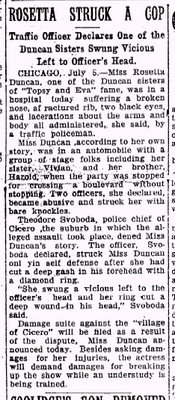 dream of.
dream of.
You don't last that long without hitting a few bumps in the road, and the Duncans were no exceptions. Marriages, both successful and not, highly publicized divorce trials, spats, litigation, hospital stays, auto accidents, and all the usual events that come to most of us without being detailed in news journals. But, for all this, the Duncans always seemed to take it on the chin and bounce back, none the worse for the wear. Although their basic performing style never seemed to change (they continued to interpolate their successful "Topsy & Eva" child characters into all their performances long after it could be carried off convincingly), they appeared to escape criticism because they were always in on the joke and never pretended to offer or be anything else than what they were --- take it or leave it.
Now, let's get back to 1924. You can read all the details in the article to the right from the Lincoln Night Journal of July 5th, but in a nutshell: With Rosetta at the wheel of a car who's contents included her sister Vivian, her brother Harold, and others, they dashed across an intersection in the Chicago suburb of Cicero --- and were stopped by a traffic cop. At this point, what happened next is speculative. 4'11", 104lb Rosetta claimed she was verbally and physically abused by the policeman, who landed a blow to her face. The cop, a strapping 6'2, 225 bloke, in turn, claims it was she who struck him --- gashing his head in the process.
Then as now, there's no such thing as bad publicity, and the Duncans lost no time in inviting photographers from the Chicago Daily News to visit them while Rosetta convalesced. In the photo below, we see brother Harold Duncan (a shadowy figure in their life whom I could find little about) who also seems to have experienced injuries that went unreported in any news account I've read, Rosetta Duncan --- sporting a standard issue concussion bandage along with a bit of plaster tape to the nose, and the entirely unscathed Vivian Duncan.
Rosetta Duncan --- sporting a standard issue concussion bandage along with a bit of plaster tape to the nose, and the entirely unscathed Vivian Duncan.
The case would drag on, with each party embellishing and elaborating until the policeman faced an attempter murder charge --- while, in the interim, the initial traffic violation was dismissed with Rosetta paying a fine of $1 (plus costs) on or around July 16th of 1924.
Here, details as to the ultimate outcome are difficult to ascertain --- but the lack of any further news reports suggests the entire matter was dropped and forgotten.
Or was it?
In a highly contemporary move that would be admired today, the entire debacle was set to music and lyric, with the result being "The (Mean) Cicero Blues," published in November of 1924 and then preserved forever on shellac by the Duncans for Victor Records that same month and year. 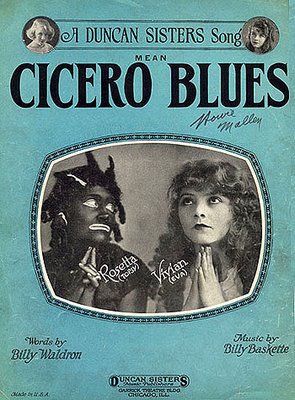
Included in their performing repertoire while the song's newsworthy value remained, "Mean Cicero Blues" exists today as what can be considered a surprisingly forward-thinking example of celebrity exploitation --- turning an unfortunate and rather mundane incident on a quiet street in the Cicero neighborhood of Chicago, into a revenue earning non-sensation.
"Mean Cicero Blues" (1924)
Years pass --- and with them, the news story and song fade into nothingness. By the late 1950's, the Duncans performed sporadically together, but Rosetta plugged on --- the born show-biz trouper personified. Occasionally, a special play date would prompt Vivian to join the act again, as she would do in early December of 1959 at a Chicago night club that featured a nostalgia-themed floor show. The 1920's had become just distant enough as to become nostalgic, and the Duncans were there as living reminders of an earlier day and form of entertainment.
After one of these performances, as Rosetta was driving to a friend's home, she lost control of her car and it crashed into a bridge post --- with Rosetta suffering fatal injuries and dying soon thereafter without ever regaining consciousness.
Although the incident of 1924 was, by every indication, forgotten by the news services, surely Vivian Duncan couldn't help but notice the irony of that her sister's fatal car accident happened to take place in the still quiet suburb of Chicago known as Cicero.
Chicago Daily News Photo #DN-0077122, Courtesy of the Chicago Historical Society
Addendum:
My personal favorite of all the Duncan Sisters' many recordings, "The Argentine, the Portuguese and the Greek," recorded in the U.K. for HMV in 1928. You may find the subject matter odd, or inflammatory... or both, but stick with it until the end and you just may well be as surprised as most listeners are upon hearing it for the first time:
Left: Jed Prouty and Rosetta Duncan in a scene from "It's A Great Life," (MGM-1929)
Right: Rosetta Duncan's grave marker, Forest Lawn Memorial Park, Los Angeles, California
25 October 2006
An Organ Interlude
But, for a brief time --- at the dawn of the sound film, the two elements not only co-existed, but did so peacefully... if not a bit uneasily. Established cinema orchestras would record elaborately arranged medleys and overtures for early musical films that would, in turn, soon make them obsolete, and cinema organs in virtually every theater in which one was installed, would entertain and lull arriving and departing audiences with tunes from recent and forthcoming films. Most established radio stations had one too, which was called into use whenever air time needed to be filled --- in addition to setting the appropriate mood and theme music for numerous early radio shows. So accepted and appreciated was the sound of this instrument, that it's rare to see an early radio broadcast schedule without noticing one or more "Organ Interludes" placed throughout the broadcast day.
Among the comparatively few recorded examples that survive today (radio transcription discs of the late 20's and early 30's have an especially low survival rate) a few have struck me as especially evocative and are well worth sharing here.
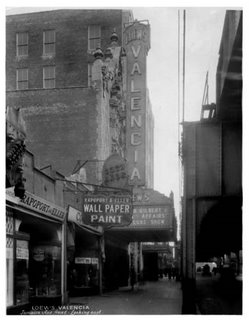 On a cold day in late March of 1929, a day that I imagine looked not far different than the view seen here, performer John Gart was called upon to play the installed Morton Organ at the Loew's Valencia theater (Queens, New York and still extant, remarkably) for the purpose of recording a disc for the Edison Phonograph Company, an organization soon to cease operation forever for a variety of sad yet inevitable reasons.
On a cold day in late March of 1929, a day that I imagine looked not far different than the view seen here, performer John Gart was called upon to play the installed Morton Organ at the Loew's Valencia theater (Queens, New York and still extant, remarkably) for the purpose of recording a disc for the Edison Phonograph Company, an organization soon to cease operation forever for a variety of sad yet inevitable reasons.Edison's relatively new "Needle Type" electric records, while of superb quality, would come far too late in the game to make much of an impression, aesthetic or financial, and would prove to be the last dying gasp of a company that served to introduce recorded sound to much of the world's population.
It's a bittersweet experience to listen to this recording when you pause to consider the bleak outlook for both the recording company and the instrument being played --- and even more so, perhaps, when it's discovered that the selected tune is a "theme song" from an early hybrid form of sound film, the part-talkie. Bittersweet because it was the Edison company that attempted to develop and nurture the medium of the talking film long before it was technologically possible and was, in effect, a stillborn life. And yet, at the very end of the Edison company's life, here it was... witnessing and promoting the very medium it helped to create.
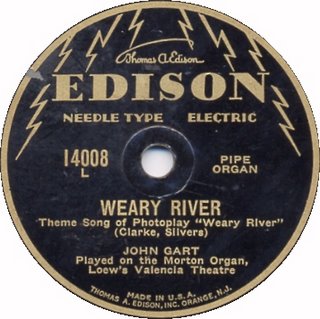
The tune, "Weary River," is from the Warner Bros. & First National photoplay of the same name, a part-talkie released early in 1929... and a film which somehow managed to beat the odds and survive intact today, looking and sounding much as it did when first released: sharp, clear and vibrant.
As with most part-talkies, and indeed early talkies in general, it's an easy target for derision by a modern audience clearly divided between a fondness for the silent film and the smooth, established talking film that would emerge by 1930. Therefore, it can't help to not entirely satisfy either faction in some way... and, as with most things, it's easier to find fault and laugh at something rather than attempt to understand it as best we can.
That aside, there's no denying that for the audiences who originally attended the film, it must have been a startling revelation to hear the long established star of the film, Richard Barthelmess, speak from the screen for the first time, as he did some ten minutes into the film's running time. The film, when seen from this difficult but rewarding viewpoint, is a fascinating artifact of both cinema and technology history --- not to mention moderately painless entertainment.
Audio addendum:
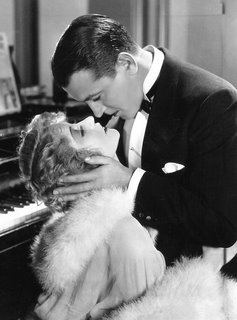
1) Theme song of the Photoplay "Weary River," as performed by John Gart on the Loew's Valencia Theatre Morton Wonder Organ in March of 1930. (Pictured right, Richard Barthelmess and Betty Compson in a scene from the film.
"Weary River" (1929)
2) "My Song of the Nile," the theme song of the 1929 Warner Bros. film "Drag," a lost silent film (also starring Richard Barthelmess) that was released with a synchronized Vitaphone music and vocal effects soundtrack. Performed here in October of 1929 by Newell Alton on the Capitol Theatre, Melbourne, Australia. A fine vocal refrain is also featured, although whether or not it's provided by the organist is unknown. One needs an exceptionally robust voice to sing with a pipe organ, and the fellow here, whoever he may be, is more than up to the task!
"My Song of the Nile" (1929)
3) "Am I Blue?", from the 1929 Warner Bros. All-Technicolor film "On With the Show!," as performed by Jean DePayne on the 23rd of August, 1929 and released on the Romeo 78rpm label. Again, it's unknown if the plaintive vocal is by the organist. Should anyone be able to verify the vocalist on this and the previous recording, you're invited to contact me.
"Am I Blue?" (1929)
###
Hearts Forever Plighted
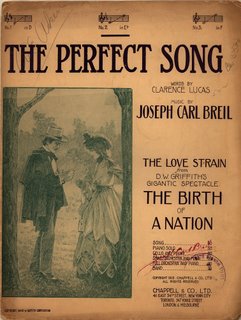 For all the controversy, real and imagined, forever embedded within D.W. Griffith's magnificent "The Birth of a Nation," there can be found one element that defies criticism and time itself --- that being a musical piece composed and compiled for the film by Joseph Carl Breil.
For all the controversy, real and imagined, forever embedded within D.W. Griffith's magnificent "The Birth of a Nation," there can be found one element that defies criticism and time itself --- that being a musical piece composed and compiled for the film by Joseph Carl Breil.Titled "The Perfect Song," further defined as a "love strain," and serving as what would eventually become to be known as a theme song, it's an incredibly lovely composition that, when disconnected from the context of the film, stands up remarkably well as a melody of no particular time nor place --- but still unmistakably stirring and evocative.
How beautifully right, then... or wrong, depending upon how you look at it, that the same melody that accompanied one of the earliest motion picture blockbusters should come to be used --- some fourteen years after it's introduction in 1915, as the theme for the "Amos 'n Andy" radio show, itself a blockbuster and landmark in broadcasting history.

Initially heard as a languid organ solo that bookended the transcribed portion of the show --- and often performed live by a radio station house musician, the melody soon caught the public's fancy, many of whom surely recalled the tune's origin. But, by 1929, Griffith's film was a distant relic of another day --- and the melody would soon become inseparable from the brilliant comedic character creations of Freeman Gosden and Charles Correll.
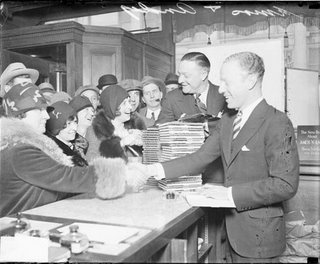 Here, to our left, is Gosden and Correll autographing copies of a slim book entitled "All About Amos 'n Andy" for delighted fans in a Chicago department store, in 1929 --- just as their radio show and their popularity were exploding across the country.
Here, to our left, is Gosden and Correll autographing copies of a slim book entitled "All About Amos 'n Andy" for delighted fans in a Chicago department store, in 1929 --- just as their radio show and their popularity were exploding across the country.In an example of cross-promotion of the sort we usually prefer to believe is a relatively modern concept, one could, in 1930, listen to the radio show, buy at least two published books, see the performers in the RKO film "Check and Double Check," read a daily comic strip syndicated to newspapers nationwide and then, at the end of the day, dance to the show's theme song --- "A Perfect Song," now far, far removed from it's original but no less dramatic source.
Here then, is a 78rpm recording of "The Perfect Song," as performed by the Hotel Pennsylvania Orchestra, with vocals, recorded on January 15th of 1930, and issued on the Velvet-Tone label.
The Perfect Song (1930)
Freeman & Gosden image courtesy of the Chicago Historical Society,Chicago Daily News negatives collection, DN-0087461.
###
24 October 2006
By Way of Introduction...
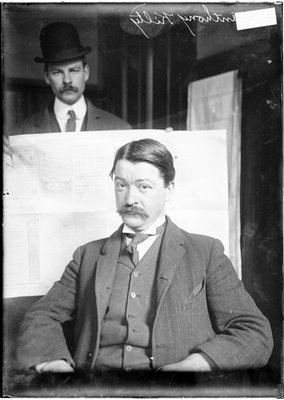
Meet Mr. Anthony Kilty, whom we see here in early November of 1907. His story, like so much of the past, exists today only in scattered fragments made up of crumbling paper, rotting celluloid, granulating wax cylinders, and the slow but sure self-destruction of nearly every medium science, technology and invention has brought forth.
These bits and pieces of our past, once so important and vital, are now artifacts that are either ignored, destroyed entirely, collected by some as one would collect stamps, or simply momentarily appreciated for having survived at all and then quickly forgotten once again.
Then, there are those like myself, who can't help but attempt to interpret them --- to place them into their proper historic prospective, and try to understand (although I never fully can) the world in which they either lived and breathed, or moved, or strived to entertain a public about to experience an onrush of technological development the likes of which hadn't occurred before or since.
At first glance, this dapper fellow seems moderately well dressed and neatly groomed in the style of his day, doesn't he?
But look again. Look at the small details.
A suit that while not shabby, could do with a pressing. A vest that doesn't quite match the weave and pattern of the jacket. The necktie that is somewhat askew. His hair, auburn I suppose, hasn't been combed as it would be for a portrait --- and his handsome moustache, also auburn, is decidedly uneven.
And behind him? The stern looking fellow in the derby hat is holding up a newspaper behind him so as to prevent details of his face and figure from blending into the dark wood interior of the room --- which, as it turns out, is a police station.
In fact, only moments before, Mr. Anthony Kilty had walked into an unspecified Evanston, Illinois police station and rather than report a crime, as I suppose anyone present might have expected, he announced that he wished to turn himself in... that he was a wanted criminal.
When pressed upon to tell his story, Kilty claimed it was all due to hard luck. He admitted that his first "job" took him to Northwestern University, where he attempted to steal clothing from a cloak room adjacent to a social frolic in progress. He inadvertently frightened a pair of co-eds who happened in upon him, and he fled... empty handed.
Ambitious, if nothing else, one evening during the first week of November, he gained entry to the home of one L.A. Eliel of Evanston, Illinois, a wealthy broker. Here, Kilty's apparent lack of stealth and skill would work against him once again, for he was soon discovered by Mr. Eliel himself, in the midst of gathering up whatever loot he could.
Oddly, Mr. Eliel, late middle-aged, distinguished and educated, did not sound an alarm, cry out or even seek to deter Anthony Kilty. As described in a contemporary newspaper account --- far removed from the source of the photograph --- let's hear Kilty tell his story as filtered through policemen, newspaper reporters and City Desk editors: "With a lump in his throat, and a suspicious moisture in his eyes, he described his visit to Eliel's house. He said that Eliel treated him so nicely (they had chatted and shared the broker's expensive cigarettes,) that when he (Eliel) asked him not to awaken the children for fear they would jump out of the window, he didn't have the heart to do it."
"Then," the newspaper account continues, "just as he was leaving with his loot, a tiny tot came running into the room and he just had to pause, stoop and kiss her. A few days ago, Kilty said he was walking on Clark Street, and spied the 'Welcome Men' sign on Dr. Terry's (an evangelist) big tent. He went inside, heard the sermon, and was all broke up by it. He then decided to make his peace with the law and his God, and give himself up."
And here, as if to punctuate the end of that newspaper article, is an image of Mr. Kilty and his kindly victim, Mr. Eliel... with a fatherly hand on Kilty's shoulder, offering a handshake of congratulation for having done the right thing.
At this point, the mists of time swirl thickly and swallow up both Mr. Kilty and Mr. Eliel, at least as far as I have been able to determine. It doesn't look as though Mr. Eliel would have pressed charges, although nothing was printed to indicate otherwise. Did Eliel offer Mr. Kilty an honest living after he paid his debt to society? Did Kilty serve time in prison and then discover, upon release, that Mr. Eliel had since passed away and with him a promise of redemption?
All that's left of Kilty, Eliel and a forgotten night of 1907 are these images, a perfunctory newspaper account and the knowledge that a gentle thief with auburn hair paused to kiss a little girl before stealing away into the clear, chilly night.
###
Glass photo negatives courtesy of the Chicago Daily News Negatives Collection, The Chicago Historical Society, DN-0005419, DN-0005418 & DN-0005416.

